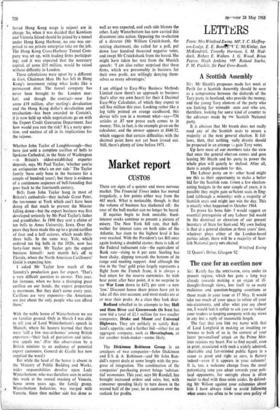Market report
CUSTOS
There are signs of a quieter and more nervous market. The Financial Times index has moved irregularly, a few points either way from the 465 mark. What is noticeable, though, is that the volume of business has slackened off: the roar of the bull market can no longer be heard.
If equities begin to look unstable, fixed- interest stocks continue to present a picture of misery. The New York bill rate, that bell- wether for interest rates on both sides of the Atlantic, has risen to the highest level it has ever reached. With the President's tax Bill once again looking a doubtful starter, there is talk of the Federal rediscount rate—the equivalent of Bank rate—rising to 6 per cent. Sterling has been shaky, dipping towards the bottom of its range and needing support. And although the rise in the 'free' gold price largely represents a flight from the French franc, it is always a bad omen for the reserve currencies. So with bear point after bear point; it is no surprise to see War Loan down to £471 per cent—a new `low.' Discount house share prices have yet to take all this into account, and most stocks are at or near their peaks. As a class they look dear.
Redland rebuffed in its attempts to buy Hall and Ham River and Greenwoods (St Ives) has now bid a total of £2.1 million for two smaller companies, Drake and Mount and Universal Highways. They are unlikely to satisfy Red- land's appetite, and a further bid—either for an aggregate company, such as Hoveringham, or for another brick-maker—seems likely.
The Dickinson Robinson Group is an amalgam of two companies—John Dickinson and E.S. & A. Robinson—and Mr John Ran- dall's report deals at some length with the pro- gress of integration. The combination of the companies' purchasing power brings 'substan- tial' economies. This year, says Mr Randall, has brought increased orders and sales, but, with consumer spending likely to turn down in the second half of the year, he is cautious over the outlook for profits.






































 Previous page
Previous page